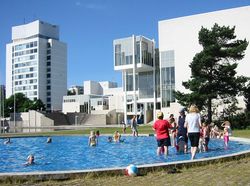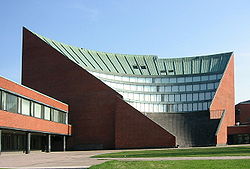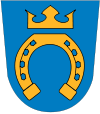Espoo
| Espoo Espoo – Esbo |
|||
|---|---|---|---|
| — City — | |||
| Espoon kaupunki Esbo stad |
|||
 |
|||
|
|||
 |
|||
| Coordinates: | |||
| Country | Finland | ||
| Region | Uusimaa | ||
| Sub-region | Greater Helsinki | ||
| Charter | 1458 | ||
| City | 1972 | ||
| Government | |||
| - City manager | Marketta Kokkonen | ||
| Area(2010-01-01)[1] | |||
| - Total | 528.16 km2 (203.9 sq mi) | ||
| - Land | 312.22 km2 (120.5 sq mi) | ||
| - Water | 215.94 km2 (83.4 sq mi) | ||
| Area rank | 223rd largest in Finland | ||
| Population (2010-03-31)[2] | |||
| - Total | 244,930 | ||
| - Rank | 2nd largest in Finland | ||
| - Density | 784.48/km2 (2,031.8/sq mi) | ||
| Population by native language[3] | |||
| - Finnish | 83.6% (official) | ||
| - Swedish | 8.3% (official) | ||
| - Others | 8% | ||
| Population by age[4] | |||
| - 0 to 14 | 19.7% | ||
| - 15 to 64 | 69.8% | ||
| - 65 or older | 10.5% | ||
| Time zone | EET (UTC+2) | ||
| - Summer (DST) | EEST (UTC+3) | ||
| Municipal tax rate[5] | 17.75% | ||
| Website | www.espoo.fi (Finnish) (Swedish) (English) | ||
Espoo (Finnish pronunciation: [ˈespoː]; Swedish: Esbo, [ˈɛsbo]) is the second largest city and municipality in Finland. The population of the city of Espoo is 244,930 (31 March 2010)[2]. It is part of the Helsinki Metropolitan Area along with the cities of Helsinki, Vantaa, and Kauniainen. Espoo shares its eastern border with Helsinki and Vantaa, while enclosing Kauniainen. Today, Espoo is the only municipality in Finland to fully enclose another municipality. The city is on the shore of the Gulf of Finland, in the region of Uusimaa.
Other bordering municipalities of Espoo are Nurmijärvi and Vihti in the north and Kirkkonummi in the west. The national park of Nuuksio is situated in northwest Espoo.
Espoo encompasses 528 square kilometres (204 sq mi), of which 312 km2 (120 sq mi) is land.[1]
Espoo has several local regional centers. Espoo is thus divided into seven major areas (Finnish: suuralueet, Swedish: storområden): Vanha-Espoo (with administrative center), Suur-Espoonlahti, Pohjois-Espoo, Suur-Kauklahti, Suur-Leppävaara, Suur-Matinkylä and Suur-Tapiola.
The Helsinki University of Technology is based in Otaniemi, Espoo, along with a thriving science community that includes numerous startups and organizations such as VTT – the Technical Research Center of Finland. Nokia, the telecommunications company, is headquartered in Keilaniemi, Espoo, along with other high-tech companies such as KONE, Tekla and Fortum.
The city of Espoo is officially bilingual. The majority of the population speaks Finnish as their mother tongue and they stand at 83.6% of the population. The minority speaks Finland Swedish and they stand at 8.3 percent of the population. Espoo's population that has a first language other than Finnish or Swedish stand at 8% of the population.
Contents |
History
The first inhabitants in the area arrived about 9,000 years ago. A permanent settlement was established during the 12th and 13th centuries. The King's Road that passes through Espoo on its way from Stockholm via Turku to Viipuri dates back to the 13th century. The oldest preserved building in Espoo, the Espoo Cathedral, originates from the 1480s. The administrative center Espoon keskus has grown around the church and the railway station.
In 1920, Espoo was only a rural municipality of about 9,000 inhabitants, of whom 70% were Swedish speaking. Agriculture was the primary source of income, with 75% of the population making their living from farming. Kauniainen was separated from Espoo in 1920, and it gained city rights the same year as Espoo, in 1972.
Espoo started to grow rapidly in the 1940s and '50s. It quickly developed from a rural municipality into a fully-fledged industrial city, gaining city rights in 1972. Due to its proximity to Helsinki, Espoo soon became popular amongst people working in the capital. In the fifty years from 1950 to 2000, the population of Espoo grew from 22,000 to 210,000. Since 1945, the majority of people in Espoo have been Finnish speaking. In 2006, the Swedish speaking inhabitants represented barely 9% of the total population. The population growth is still continuing, but at a slower rate.
Name
The name Espoo probably comes from the Swedish name for the River Espoo, Espå (or Espåå), which in turn comes from the old Swedish word äspe, meaning a border of aspen, and the Swedish word for "river", å, thus "a river bordered by aspen". The name was first mentioned in 1431.
Demographics
| Historical population of Espoo [1] | |||
|---|---|---|---|
| Year | Population | Year | Population |
| 1901 | 5,888 | 1975 | 120,632 |
| 1910 | 7,891 | 1980 | 137,409 |
| 1920 | 8,817 | 1985 | 156,778 |
| 1930 | 11,370 | 1990 | 172,629 |
| 1940 | 13,378 | 1995 | 193,754 |
| 1950 | 22,878 | 2000 | 213,271 |
| 1960 | 53,042 | 2006 | 235,019 |
| 1970 | 92,655 | 2030 (est.) | 305,000 |
| Population by grand district (in 2006) | |||
| Area | Population | Area | Population |
| Leppävaara | 58,048 | Vanha-Espoo | 33,613 |
| Espoonlahti | 48,649 | Pohjois-Espoo | 9,754 |
| Tapiola | 41,905 | Kauklahti | 6,191 |
| Matinkylä | 33,613 | ||
The population by nationality 1 January 2007 was 95.1% Finnish and 4.9% other nationalities. Religious affiliation was 77.4% Lutheran, 1.3% Orthodox, 1.3% other, 19.9% no religious affiliation.
Espoo contains many high income suburbs, and six out of the ten highest average income postal code areas in Finland are in Espoo.
Culture
Espoo hosts a Museum of Modern Art called EMMA (Espoo Museum of Modern Art), built in a renovated old print house, the WeeGee house, named after an old book print company Weilin & Göös. The same building hosts also Finland's only Museum of Horology (Finnish: Kellomuseo, Swedish: Urmuseum) and a Toy Museum. In Tapiola (Swedish: Hagalund), is located a Culture House, where numerous concerts, and theater performances are held.
Espoo has several manors two of which are open to the public. The most important is Espoon kartano (Swedish: Esbo gård, Espoo Manor), mentioned first time in 1495, and belonging to the noble Ramsay family since 1756. The current main building dates from 1914, but a mill dates from the 1750s and Finland oldest walved stone bridge from 1777 is on the King's Road (Finnish: Kuninkaantie, Swedish: Kungsvägen) which passes by the manor. The main building can be rented for weddings and similar occasions. Guided tours on request for groups. The other manor open to public is Pakankylän kartano, located on the northern shore of Lake Bodom. The manor hosts a restaurant and club rooms, partly with original furniture open to the public, but meant original to Kaisankoti sanatory and old people's home located on ground of the manor.
The Melodic Death Metal band Children of Bodom comes from Espoo, Finland. They are named after the unsolved murder known as the Lake Bodom murders which took place at Lake Bodom, a lake in northern Espoo. The bands Norther and Kiuas also come from Espoo.
Sports
At the 1952 Summer Olympics, the city's Westend Tennis Hall hosted the fencing events.
Espoo is home to several premier league sports teams. The Espoo Blues play at Barona Areena in the SM-Liiga – professional ice hockey league. The club was established in February 1984 as "Kiekko-Espoo" and played their first season in 1984–1985 in the Finnish Second Division. In 1988 they achieved a place on the Finnish First Division and in 1992 they celebrated their promotion to the SM-liiga. The club and the team changed their name in 1998. The name came from the dominant colour of their home jersey. The full name of the club is Blues Hockey Oy.
The Blues are a contender for the title almost every year, but have yet to win the series. They have come second several times though.
Another sports club from Espoo, FC Honka, is a football club based in Tapiola in southern Espoo. It was promoted into the Finnish premier division (Veikkausliiga) for the first time in its history at the end of the 2005 season. The manager of the club is Mika Lehkosuo, and it plays its home matches at Tapiolan urheilupuisto. Originally founded in 1953 as "Tapion Honka", it changed its name into FC Honka in 1975.
FC Honka is largely known in Finland for its extensive youth scheme with over 1000 young players playing in various age groups.
Espoo is the birthplace of 2000 and 2002 World Rally Champion Marcus Grönholm, 2007 Formula One World Champion Kimi Räikkönen, Dallas Stars forward Jere Lehtinen (three time NHL Selke Trophy winner), former Formula One driver JJ Lehto,professional downhill mountain biker Matti Lehikoinen, and 2009 European Figure Skating Champion Laura Lepistö.
| Club | Sport | League | Stadium | Logo |
| FC Honka | Football | Veikkausliiga | Tapiolan urheilupuisto | |
| Espoo Blues | Ice hockey | SM-liiga | LänsiAuto Areena | |
| Espoo Blues | Ice hockey | Women's SM series | Laaksolahti Arena | |
| Tapiolan Honka | Basketball | Korisliiga | Tapiolan urheiluhalli | |
| Espoon Oilers | Floorball | Salibandyliiga | Tapiolan urheiluhalli | |
| Uinti-Espoo "Cetus" | Swimming | - | Espoonlahden uimahalli | |
| Espoo Lentis | Volleyball | - | Espoonlahden urheiluhalli |
Gallery
 The headquarters of Fortum, located in Keilaniemi, Espoo |
 The Helsinki University of Technology, in Otaniemi, Espoo |
 Nokia world headquarters in Keilaniemi, Espoo |
 The 55 districts of Espoo |
 Espoo Cathedral |
 Leppävaara railway station |
 Träskända Mansion in Espoo |
International relations
Twin towns — Sister cities
Espoo is twinned with:

|
See also
- The UN's Convention on Environmental Impact Assessment in a Transboundary Context, signed in Espoo 1991 (text of Convention)
- Districts of Espoo
- Sello mall shooting
References
- Espoon kaupungin taskutilasto 2007, issued by the City of Espoo, 2007
Notes
- ↑ 1.0 1.1 "Area by municipality as of 1 January 2010" (in Finnish and Swedish) (PDF). Land Survey of Finland. http://www.maanmittauslaitos.fi/sites/default/files/pinta_alat_kunnittain_01012010.pdf. Retrieved 23 November 2010.
- ↑ 2.0 2.1 "Population by municipality as of 31 March 2010" (in Finnish and Swedish). Population Information System. Population Register Center of Finland. http://www.vrk.fi/vrk/files.nsf/files/ACFC13B2F489698CC22577030039BD73/$file/20100331.htm. Retrieved 13 April 2010.
- ↑ "Population according to language and the number of foreigners and land area km2 by area as of 31 December 2008". Statistics Finland's PX-Web databases. Statistics Finland. http://pxweb2.stat.fi/Dialog/varval.asp?ma=060_vaerak_tau_107_fi&ti=V%E4est%F6+kielen+mukaan+sek%E4+ulkomaan+kansalaisten+m%E4%E4r%E4+ja+maa%2Dpinta%2Dala+alueittain++1980+%2D+2008&path=../Database/StatFin/vrm/vaerak/&lang=3&multilang=fi. Retrieved 29 March 2009.
- ↑ "Population according to age and gender by area as of 31 December 2008". Statistics Finland's PX-Web databases. Statistics Finland. http://pxweb2.stat.fi/Dialog/varval.asp?ma=050_vaerak_tau_104_fi&ti=V%E4est%F6+i%E4n+%281%2Dv%2E%29+ja+sukupuolen+mukaan+alueittain+1980+%2D+2008&path=../Database/StatFin/vrm/vaerak/&lang=3&multilang=fi. Retrieved 28 April 2009.
- ↑ "List of municipal and parish tax rates in 2010". Tax Administration of Finland. 24 November 2009. http://www.vero.fi/download.asp?id=5853;25512. Retrieved 13 January 2010.
External links
- 1952 Summer Olympics official report. p. 50.
- City of Espoo – Official website (Finnish)
- City of Espoo (Esbo) – Official website (Swedish)
- City of Espoo – Official website (English)
- Espoo Convention & Marketing Espoo for travellers (Finnish) (Swedish) (English)
- Helsinki University of Technology – located in Espoo (Finnish) (Swedish) (English)
- Helsinki.fi – Helsinki region in a nutshell (Finnish) (Swedish) (English)
|
|||||||||||||||||||||||||
|
||||||||||||||
|
|||||


